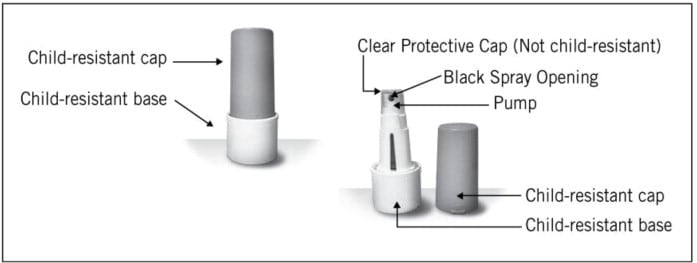What is Zolpimist?
Zolpimist is a sedative-hypnotic (sleep) medicine. Zolpimist is used in adults for the short-term treatment of a sleep problem called insomnia. Symptoms of insomnia include:
- trouble falling asleep
Zolpimist is not for children.
Zolpimist is a federally controlled substance (C-IV) because it can be abused and lead to dependence. Keep Zolpimist in a safe place to prevent misuse and abuse. Selling or giving away Zolpimist may harm others and is against the law. Tell your doctor if you have ever abused or have been dependent on alcohol, prescription medicines, or street drugs.
What is the most important information I should know about Zolpimist?
Complex sleep behaviors that have caused serious injury and death. After taking Zolpimist, you may get up out of bed while not being fully awake and do an activity that you do not know you are doing (complex sleep behaviors). The next morning, you may not remember that you did anything during the night. These activities may happen whether or not you drink alcohol or take other medicines that make you sleepy with Zolpimist. Reported activities include:
- driving a car (“sleep-driving”)
- making and eating food
- talking on the phone
- having sex
- sleep-walking
Stop taking Zolpimist and call your doctor right away if you find out that you have done any of the above activities after taking Zolpimist.
Important:
1. Take Zolpimist exactly as prescribed
- Do not take more Zolpimist than prescribed.
- Take Zolpimist right before you get in bed, not sooner.
2. Do not take Zolpimist if you:
- have ever experienced a complex sleep behavior (such as driving a car, making and eating food, talking on the phone or having sex while not fully awake) after taking Zolpimist
- drink alcohol
- take other medicines that can make you sleepy. Talk to your doctor about all of your medicines. Your doctor will tell you if you can take Zolpimist with your other medicines.
- cannot get a full night sleep
Who should not take Zolpimist?
Do not take Zolpimist if you have had an allergic reaction to zolpidem (Ambien, Ambien CR, Zolpimist). Some signs of allergic reaction may be swelling of the face, a feeling of the throat closing, or difficulty breathing shortly after taking Zolpidem.
See the end of this Medication Guide for a complete list of ingredients in Zolpimist.
What should I tell my healthcare provider before taking Zolpimist?
Zolpimist may not be right for you. Before starting Zolpimist, tell your doctor about all of your health conditions, including if you:
- have a history of depression, mental illness, or suicidal thoughts
- have a history of drug or alcohol abuse or addiction
- have kidney or liver disease
- have a lung disease or breathing problems
- are pregnant, planning to become pregnant, or breastfeeding
Tell your doctor about all the medicines you take including prescription and nonprescription medicines, vitamins, and herbal supplements. Medicines can interact with each other, sometimes causing serious side effects. Do not take Zolpimist with other medicines that can make you sleepy.
Know the medicines you take. Keep a list of your medicines with you to show your doctor and pharmacist each time you get a new medicine.
How should I take Zolpimist?
- Read the Instructions for use that come with Zolpimist.
- Take Zolpimist exactly as prescribed. Do not take more Zolpimist than prescribed for you.
- Take Zolpimist right before you get into bed.
- Do not take Zolpimist unless you are able to stay in bed a full night (7-8 hours) before you must be active again.
- For faster sleep onset, Zolpimist should NOT be taken with or immediately after a meal.
- Call your doctor if your insomnia worsens or is not better within 7 to 10 days. This may mean that there is another condition causing your sleep problem.
- If you take too much Zolpimist or overdose, call your doctor or poison control center right away, or get emergency treatment.
What are the possible side effects of Zolpimist?
Serious side effects of Zolpimist include:
- getting out of bed while not being fully awake and doing an activity that you do not know you are doing. See “What is the most important information I should know about Zolpimist?”)
- abnormal thoughts and behavior. Symptoms include more outgoing or aggressive behavior than normal, confusion, agitation, hallucinations, worsening of depression, and suicidal thoughts or actions.
- memory loss
- anxiety
- severe allergic reactions. Symptoms include: swelling of the tongue or throat, trouble breathing, and nausea and vomiting. Get emergency medical help if you get these symptoms after taking Zolpimist.
Call your doctor right away if you have any of the above side effects or any other side effects that worry you while using Zolpimist.
The most common side effects of Zolpimist are:
- drowsiness
- dizziness
- diarrhea
- “drugged feelings”
- You may still feel drowsy the next day after taking Zolpimist. Do not drive or do other dangerous activities after taking Zolpimist until you feel fully awake.
After you stop taking a sleep medicine, you may have symptoms for 1 or 2 days such as: tiredness, trouble sleeping, nausea, flushing, lightheadedness, uncontrolled crying, vomiting, stomach cramps, panic attack, nervousness, and stomach area pain.
These are not all the side effects of Zolpimist. Ask your doctor or pharmacist for more information.
Call your doctor for medical advice about side effects. You may report side effects to FDA at 1-800-FDA-1088.
General information about the safe and effective use of Zolpimist
- Medicines are sometimes prescribed for purposes other than those listed in a Medication Guide.
- Do not use Zolpimist for a condition for which it was not prescribed
- Do not share Zolpimist with other people, even if you think they may have the same symptoms that you have. It may harm them, and it is against the law.
This Medication Guide summarizes the most important information about Zolpimist. If you would like more information, talk with your doctor. You can ask your doctor or pharmacist for information about Zolpimist that is written for healthcare professionals. For more information about Zolpimist, call 1-855-298-8246.
How should I store Zolpimist?
- Store Zolpimist in an upright position at 59°F to 86°F (15°C to 30°C).
- Do not freeze.
- Avoid prolonged product exposure above 86°F (30°C).
- The child-resistant container should be thrown away when the 60 sprays have been used.
Keep Zolpimist and all medicines out of reach of children.
What are the ingredients in Zolpimist?
Active Ingredient: Zolpidem tartrate
Inactive Ingredients: artificial cherry flavor, benzoic acid, citric acid monohydrate, hydrochloric acid, neotame, propylene glycol, and purified water.
Instructions for use for Zolpimist
Zolpimist (zolpidem tartrate)
Oral Spray, Metered for Oral Use

Priming:
Before you use Zolpimist for the first time or if you have not used Zolpimist for 14 days, you will need to prime the pump (Steps 1-6). Otherwise go directly to Step 7.
To prime the pump:
1. Line up the arrows on the child-resistant cap and base (see Figure 1).
2. Squeeze the cap at arrows (see Figure 2).
3. Pull the cap and base to separate (see Figure 3).
4. Remove the clear protective cap from the pump (see Figure 4).
5. Hold the container upright. Point the black spray opening in a safe direction away from your face and other people. Fully press down on the pump with your forefinger. Release the pump and let the pump return to the starting position.
6. Follow step 5 and press down on the pump 4 more times. You should see a fine spray. Zolpimist is now ready to use. Now go directly to Step 11.
Taking a dose of Zolpimist:
- If you are using Zolpimist for the first time or you have not used Zolpimist for 14 days, you will need to prime the pump (Steps 1-6). Otherwise, there is no need to prime the pump.
- Take Zolpimist exactly as prescribed. Do not take more Zolpimist than prescribed for you. Your healthcare provider will tell you whether to take 1 or 2 sprays of Zolpimist.
- Take Zolpimist right before you get into bed.
- Do not take Zolpimist unless you are able to stay in bed a full night (7-8 hours) before you must be active again.
7. Line up the arrows on the child-resistant cap and base (see Figure 1).
8. Squeeze the cap at arrows (see Figure 2).
9. Pull the cap and base to separate (see Figure 3).
10. Remove the clear protective cap from the pump (see Figure 4).
11. Hold the container upright with the black spray opening pointed directly into your mouth. Fully press down on the pump to make sure that a full dose of Zolpimist is sprayed directly into your open mouth over your tongue (see Figure 5).
12. Let the pump return to the starting position. If your healthcare provider prescribed only one spray of Zolpimist (5 mg dose), go directly to Step 14.
13. If your healthcare provider prescribes a second spray of Zolpimist (10 mg dose), repeat Step 11.
14. Put the clear protective cap back over the pump at the top of the child-resistant base after each use (see Figure 6).
15. Snap the child-resistant cap back onto the base and rotate the child-resistant cap and the child-resistant base so that the arrows are not lined up (see Figure 7).
16. The child-resistant container should be thrown away when the 60 sprays have been used.

There are no special requirements for cleaning and maintaining Zolpimist. Professional assistance regarding questions about product performance or use can be obtained by calling 1-855-298-8246.
See Medication Guide section “How should I store Zolpimist?” for instructions about how to store Zolpimist.





